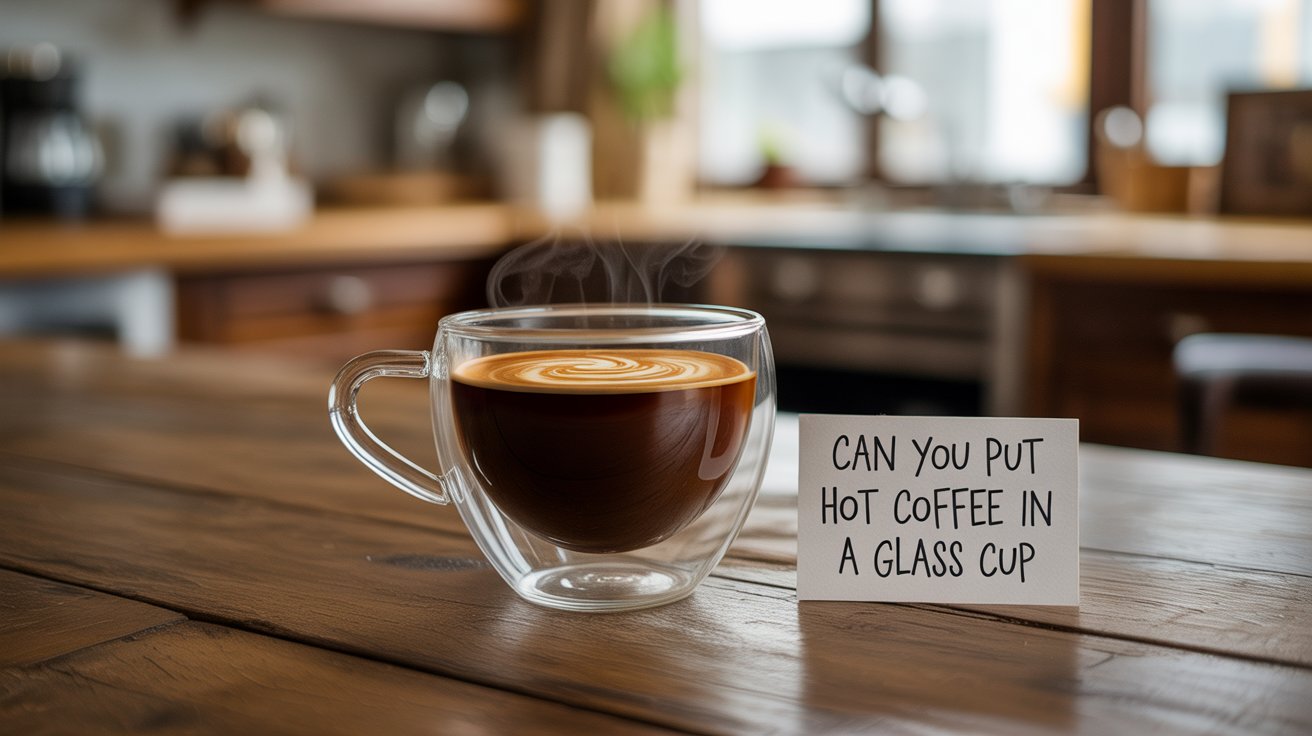Can you put hot coffee in a glass cup? Yes — but only if it’s the right type of glass and you follow a few safety steps.
The wrong mug can shatter instantly from thermal shock. I tested this myself: I poured boiling coffee into a regular soda‑lime glass… and it cracked right in my hand.
If you love the sleek look of a glass coffee cup (I do too), here’s what you need to know: not all glass is heatproof. Some are made for espresso, others are microwave-safe — and a few can’t handle heat at all.
In this guide, you’ll learn:
Which glass types are safe for hot coffee (and which aren’t)
How to avoid glass breakage and burns
The science behind thermal shock
What real users are saying (including burn reports)
The best heat-safe glass cups you can actually trust
No fluff. Just straight answers, safety-tested tips, and expert-backed advice.
Let’s dive in — before your next cup cracks.
The Problem: Pouring Hot Coffee Into Glass Can Be Risky
Yes, you can pour hot coffee into a glass cup — but if you choose the wrong type, it might crack or even shatter in your hand.
That’s not fear-mongering. It’s physics.
Let’s break down why this happens and how to avoid it.
Thermal Shock Is the Silent Mug Killer
When a cold or poorly-made glass cup meets a sudden burst of heat, like freshly brewed coffee, the temperature difference causes thermal stress.
And if the glass can’t handle it?
It breaks.
Not All Glass Is Created Equal
Here’s how the most common glass types stack up:
| Glass Type | Max Temp Tolerance | Thermal Shock Resistant? | Best For |
|---|---|---|---|
| Soda-lime | ~175°F / 80°C | ❌ No | Cold drinks only |
| Tempered Glass | ~300°F / 150°C | ⚠️ Moderate | Hot drinks with care |
| Borosilicate | ~500°F / 260°C | ✅ Yes | Best for hot beverages |
| Double-wall glass | Varies (usually borosilicate) | ✅ Yes (if borosilicate) | Coffee, espresso, tea |
Borosilicate glass is your best bet. It expands less, resists cracking, and handles sudden heat like a pro.
Fun fact: It’s the same material used in lab beakers and high-end cookware.
Real Incidents You Should Know About
In 2024, over 580,000 JoyJolt Declan glass mugs were recalled after 56 burn injuries and 103 reports of glass shattering (AP News).
These weren’t cheap mugs from a discount store.
They were marketed as high-end, yet couldn’t withstand daily use with hot beverages.
And this isn’t a new problem. Remember the infamous Liebeck v. McDonald’s case? A spilled cup of coffee caused third-degree burns — and although it involved a paper cup, it sparked industry-wide safety reforms. Glass is even more volatile if misused.
What Real Users Say (Pain Points from the Community)
Scroll through Reddit or coffee forums and you’ll see it:
“Glass is a poor insulator — my coffee gets cold fast.”
“I love how it looks, but I don’t trust it with boiling water.”
“Had one shatter in the sink after pouring hot brew. Never again.”
People want the elegance of glass, but fear the risk.
And it’s not just about breakage. It’s about losing heat fast and wondering if your mug is actually safe.
Health Concerns: Glass vs. Plastic vs. Steel
Many turn to glass to avoid chemical leaching found in plastics or lined metals.
And rightly so — Dr. Mark Hyman recommends glass as the cleanest, safest material for hot beverages.
But not just any glass.
Poor-quality mugs may still contain lead or untreated coatings that degrade under heat (rowellpackage.com, news.ycombinator.com).
If health is a motivator, borosilicate glass wins again. It’s inert, clean, and built for heat.
Bottom Line?
Pouring hot coffee into the wrong glass cup is risky — not just for your fingers, but for your flavor, safety, and peace of mind.
Next, we’ll show you exactly how to choose the right glass, pour safely, and enjoy your brew without the break.
The Solution: How to Safely Use Glass Cups for Hot Coffee

Yes — you can enjoy hot coffee in a glass cup without the risk… if you choose the right kind and treat it right.
This section shows you exactly how.
Choose the Right Glass (Not All Glass Is Coffee-Safe)
Here’s the deal: borosilicate is king.
It’s the same material used in lab equipment — resistant to thermal shock, crystal-clear, and food-safe.
What to Look For:
When shopping for a glass coffee cup, check for:
Borosilicate: heat-resistant up to 500°F / 260°C
Double-wall insulation: protects your hand and your coffee’s heat
Thickness: at least 3mm for durability
FDA food-safe rating: look for the fork & wine glass symbol
Microwave + dishwasher safe: most borosilicate cups are
Clarity: clean, bubble-free glass is usually better quality
Tip from Epicurious & Food & Wine: Double-wall borosilicate cups offer the best combo of safety and sleek presentation.
Avoid soda-lime glass for hot drinks. It’s cheaper — and more likely to crack.
Preheat & Pour Like a Pro
Even the best glass can break if you go from freezing cold to boiling in seconds.
Here’s how to avoid that:
Safe Pouring Protocol
Warm your mug first – run hot tap water into it for 10–20 seconds
Empty it – don’t pour directly on the water
Pour slowly – let the glass adjust as you fill
Never use a cold-from-fridge glass – big mistake
Avoid direct flame or stovetop use unless the mug is labeled heatproof for it
Reddit tip:
“Did you preheat the mugs? That’s where most people mess up.”
Even tempered or double-wall glass isn’t magic.
Treat it right, and it’ll last.
Insulation & Taste: What You Might Not Realize
Glass is beautiful — but it’s not the best at keeping coffee hot.
Unless it’s double-walled.
Double-Wall vs. Single-Wall
| Feature | Single-Wall | Double-Wall |
|---|---|---|
| Heat retention | ❌ Loses heat quickly | ✅ Keeps heat longer |
| Safe to touch | ❌ Gets hot outside | ✅ Stays cool |
| Aesthetic appeal | ✅ Clear, elegant | ✅ More “floating” effect |
| Best for | Filter coffee, espresso | Any hot drink |
According to rowellpackage.com, glass is ideal for short drinks like cortados or pour-overs — but it’s not built for sipping slowly unless insulated.
Does Glass Change Flavor?
Absolutely.
Glass doesn’t absorb or impart flavor like ceramic or steel. That’s good.
But it cools quickly — which increases perceived acidity and can mute sweetness.
Taste nerds say:
Acidity pops faster
Tannins are more noticeable
Sweetness fades as the temp drops
If you’re drinking bright, fruity light-roasts? Glass might enhance it.
But for syrupy dark roasts, go with something more heat-retentive.
Action: Buying Guide & Product Suggestions
Now that you know the “why” — here’s the “what.”
Compare Materials Side by Side
| Glass Type | Max Temp (°F/°C) | Shock Resistant | Insulation | Dishwasher Safe | Price Range |
|---|---|---|---|---|---|
| Soda-lime | ~175°F / 80°C | ❌ No | ❌ Poor | ⚠️ Sometimes | $ |
| Tempered | ~300°F / 150°C | ⚠️ Moderate | ⚠️ Average | ✅ Yes | $$ |
| Borosilicate | ~500°F / 260°C | ✅ Yes | ✅ Good | ✅ Yes | $$$ |
| Double-wall | Same as above | ✅ Yes | ✅ Excellent | ✅ Yes | $$$–$$$$ |
Borosilicate wins — especially when double-walled.
Best Brands for Hot Coffee in Glass Cups
Trusted by coffee lovers and recommended by Food & Wine and The Spruce Eats:
Zwilling Sorrento – ultra-premium, sleek double-wall
Bodum Pavina – classic, durable, and widely available
Joco Cups – eco-friendly, borosilicate, with silicone sleeves
Libbey Robusta – affordable but heat-safe
Want style and safety? Zwilling and Bodum are top-tier.
Want travel-ready options? Go with Joco.
Alternate Options (When Glass Isn’t Ideal)
Let’s be real: sometimes, glass just isn’t the right tool.
Use ceramic or stainless steel when:
You sip slowly over 30+ minutes
You want to retain heat longer
You’re on the go and need durability
You value insulation over aesthetics
Dr. Mark Hyman recommends ceramic with lead-free glaze or 316 stainless steel as ultra-safe options for daily use.
Myth‑Busting & Common QA
Glass mugs get a bad rap — and for good reason. But not every claim holds up under scrutiny. Let’s separate fact from fiction.
Myth: “All Glass Mugs Shatter with Hot Coffee”
Not true — unless you’re using the wrong type of glass.
Cheap soda-lime glass? Prone to thermal shock.
But borosilicate or tempered glass? Built for heat.
Even better: preheating your glass before pouring hot coffee reduces the temperature gap — and the risk.
Pro tip: Warm your mug under hot tap water first.
Reddit users swear by this as a simple fix.
Myth: “Double-Wall Glass Keeps Coffee Hot for Hours”
Sounds great — but it’s not quite reality.
Double-wall glass does retain heat longer than single-wall mugs.
But compared to stainless steel or vacuum-insulated tumblers, it still loses heat faster.
A Reddit user wrote: “It looks cool, but my pour-over still cooled down in 20 minutes.”
Even Food & Wine notes that double-wall mugs are better for short sessions, not marathon sipping.
Bottom line: Glass is about aesthetics and moderate insulation — not all-day heat.
FAQ: Quick Answers to Common Questions
Is glass microwave or dishwasher safe?
Yes — if it’s labeled borosilicate or tempered.
Avoid cheap glass or painted decals.
Can I pour cold coffee into a hot glass mug (or vice versa)?
No. Sudden temperature swings = thermal shock.
Let the mug adjust first.
How do I know if a glass is borosilicate?
Check the label — or look for:
Very clear glass, few bubbles
Lightweight but thick-walled
Markings like “borosilicate” or “lab-grade”
If unsure, don’t use it for hot liquids.
What temperature is safe for glass mugs?
Here’s a quick guide:
Soda-lime: max ~175°F (80°C)
Tempered: up to ~300°F (150°C)
Borosilicate: handles 500°F+ (260°C)
Data
Glass Types vs. Safe Temperature
| Glass Type | Max Temp (°F/°C) | Shock Resistance |
|---|---|---|
| Soda-lime | ~175°F / 80°C | ❌ Low |
| Tempered Glass | ~300°F / 150°C | ⚠️ Moderate |
| Borosilicate | ~500°F / 260°C | ✅ High |
Recall Stats: Real-World Risks
In 2024, the JoyJolt Declan mug recall affected:
580,000+ mugs
56 reported injuries
103 reports of glass breakage
Source: AP News
Final Sip: The Bottom Line on Glass and Hot Coffee
Yes — you can enjoy hot coffee in a glass cup. But like any good brew, it comes down to the right ingredients and careful handling.
Choose borosilicate or tempered glass, preheat before pouring, and avoid sudden temperature shocks. Respect the science, and your glass mug will reward you with clean flavor, clarity, and café-level elegance — minus the risk.
Whether you’re sipping a cortado or crafting a slow-pour, the right glass elevates the experience.
Drink smart. Pour safely. Brew beautifully.

Shahriar brings a unique blend of storytelling prowess and digital expertise to Daily Coffee Guide. With a background in SEO and content strategy, he ensures our articles on Beans, Coffee, Tea, and Drinks are both engaging and discoverable. His passion for coffee culture drives him to explore and share the rich narratives behind every cup.

